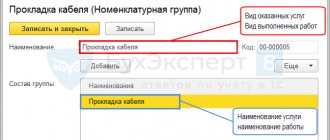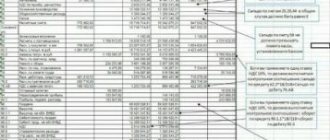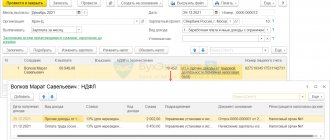On what account is it reflected?
As a rule, this tax is calculated and reflected in the balance sheet once a quarter, that is, once every 4 months. VAT can be reflected in several invoices. It depends on what the income is related to. If income is received from the main activity of the enterprise, then the tax will be charged and reflected in the Sales account (90), but if proceeds are received from the sale of other property of the company (for example, the sale of fixed assets), then the tax is reflected in account 91.
We talked about which account in the balance sheet the revenue is shown in in a separate article, and you will find more information about how it is accounted for with and without VAT here.
Revenue from sales of products in the balance sheet: liability line 1370
The “Capital and Reserves” section of the balance sheet shows the financial result obtained from revenue, i.e. profit or loss. Again, this is not the revenue itself, but only the total formed on its basis. Line 1370 records the company's retained earnings on an accrual basis from the beginning of its creation. Thus, the profit of the reporting period is included in the total profit and it is also impossible to establish its exact size on the balance sheet. This will happen only in the first year of the company’s formation - the balance sheet profit will be equal to its size according to the financial results statement.
The principles of constructing a balance sheet do not allow us to find out the specific figure of revenue received in the period under review. According to the third section of the balance sheet, it is possible to determine, if not the amount, then the fact that the company received revenue, since not a single enterprise can be profitable, form reserves, invest in its own development or increase capital without profit, which is impossible to obtain without revenue.
So, revenue from the sale of goods cannot be seen on balance sheet lines, but at the same time, the amount of revenue for the reporting period and its constituent elements appear in the “Report on Financial Results” (FR). To reflect the amount of revenue, it contains line 2110. Revenue is formed by accounting data - individual turnover in account 90 “Sales”, and the result from sales (profit or loss) corresponds to the amount of write-off of the balance on the account. 90/9 on account 99.
In accounting, operations to generate revenue, and then profit, are accompanied by the following entries:
| Operations | D/t | K/t |
| Revenue recognized: | ||
| - in production | 62 | 90/1 |
| - in trade | 50,51,55,57 | 90/1 |
| In the OFR, the value of revenue is minus excise taxes and VAT. | 90/3, 90/4 | 68 |
| Product cost | 90/2 | 20,23,25,26,41,42,43,44 |
| Closing the account 90 (balance reform), i.e. turnovers are written off: | ||
| - by revenue for the year | 90/1 | 90/9 |
| - at cost | 90/9 | 90/2 |
| - for VAT and excise taxes | 90/9 | 90/3, 90/4 |
| Revenue from sales | 90/9 | 99 |
| Lesion | 99 | 90/9 |
What to do if the amounts in the declarations differ?
When checking the documentation, regulatory authorities may see that the revenue in the VAT declaration is greater than in the profit declaration. They believe that these amounts should always be identical, but in practice this is not the case. In theory, VAT revenue should be equal to profit, but this is not always true (you can learn about the differences between revenue and profit and other accounting concepts in a special material). The Federal Tax Service may request an explanation of the declaration, considering the error to be unfounded. Then the accountant needs to attach to the explanation documents that explain all transactions made during the current quarter. The more detailed he explains the current situation, the fewer questions there will be.
Tax revenue may be less in the case when some goods or services are not subject to VAT (detailed list of goods - Article 149 of the Tax Code of the Russian Federation).
But the opposite situation also exists. When might it occur? There are transactions subject to VAT that are not taken into account when calculating income tax. For example, the gratuitous transfer of goods. For clarity, let's look at an example.
A certain woman donated some goods worth 45,000 rubles (excluding VAT) for free use. Revenue amounted to 540,000 rubles for the first quarter. Then, in the VAT return, the accountant wrote the amount 540,000 + 45,000 = 585,000. This amount is less than revenue, but this situation can be explained. When transferred free of charge, VAT is charged on goods, as with a regular sale.
Thus, with different amounts for profit and VAT, it is necessary to show why this situation arose and write an explanation about this to the tax service.
Other publications on the topic of calculating and accounting for revenue may also be useful to you, after reading which you will learn:
- What are sales revenue and gross revenue?
- How does it differ from turnover and cost?
- What formulas are used to calculate it and how to calculate the annual volume?
Revenue from sales in the balance sheet: asset lines
With a high degree of probability, it can be argued that many lines of both parts of the balance sheet are related to the revenue indicator. For example, a sharp decrease in the value of fixed assets or intangible assets (lines 1150 and 1110) at the end of the period may indicate their sale, therefore, there is reason to believe that the total revenue of the enterprise includes a share of income from the sale of these assets.
The appearance in line 1160 of the balance sheet of information about financial investments in material assets indicates not only the possible receipt of revenue from the provision of property for rent, but also about investment in the development of the company (purchase of assets for leasing) at the expense of the profit that the revenue itself generates.
Financial investments (line 1170), i.e. investing money in the purchase of securities or in the authorized capital of third-party enterprises, can also be made from the company’s profits, and the appearance of information in this line indicates both the use of profits and the expected increase in revenue.
A clearer picture of costs and income from revenue can be obtained by analyzing the data in the second section of the balance sheet. Thus, a significant decrease in inventories on line 1210 may indicate the transfer of inventory items into production or directly for sale. True, this can only be asserted if there is a sharp decrease in the balance of reserves and knowledge that they were not replenished throughout the entire reporting period.
The relationship between revenue and working capital can be viewed on line 1250 “Cash and equivalents”, since it goes to the bank account and to the cash desk. But even here it is impossible to give an unambiguous assessment of the volume of revenue received. For example, a small balance on a line does not always indicate a shortage of money in the company; it is quite possible that the company quickly finds a use for the proceeds received into the account.
You can see the amount of revenue in the balance sheet on line 1230 “Accounts receivable”, if money for the shipped goods has not been received from all customers in the reporting period and there is no other debt besides these debts, but in practice this happens extremely rarely, and the debt cannot be considered revenue . Moreover, it should be taken into account that VAT is present in the amount of unreceived revenue reflected in receivables.
Reflection in the financial results statement:
in form 2 (profit and loss statement - opiu)
In this reporting form, VAT is always indicated as a debit as part of line 2110 Profit. Order of the Ministry of Finance of Russia dated May 6, 1999 No. 32n established that revenue is the turnover on the credit of account 90-1 Revenue, reduced by the debit turnover on subaccounts 90-3 “VAT”, 90-4 Excise taxes.
On the balance sheet
The tax is reflected in the balance sheet as both an asset and a liability. In the asset it is reflected in two lines at once - 1220 and 1230, in the liability - 1520. Let us consider in more detail the formation of each part.
- Line 1220 of VAT on purchased assets is the amount of tax that the company undertakes to deduct in the future, that is, the balance of account 19 is transferred there. For many companies, by the end of the year 19, the account is reset to zero, and then there is a dash in line 1220.
- Line 1230 is accounts receivable. In other words, this line summarizes everything that buyers or customers did not pay extra (or did not pay) at the time of drawing up the balance sheet, including VAT. This also includes advances for raw materials or supplies to suppliers, which include VAT.
- Line 1520 is the company's accounts payable. That is, this is the sum of all the company’s debts, including VAT. In addition, this line also includes advances received minus VAT.
Thus, VAT is reflected: in lines 1220 and 1230 in the assets of the balance sheet and in line 1520 in the liabilities.
Tax accrued - posting
The VAT entries reflect:
- When selling a product or service.
- Input VAT.
- VAT restoration.
Let's consider each case separately and determine in which case and on which account the tax is determined.
When selling goods, this tax is always taken into account as a credit in accounts such as 68 and 76.
Commercial organizations can reduce the amount of tax payable by deducting input VAT. It is reflected as a debit in accounts 19 and 68. There are a number of cases when the tax accepted for deduction must be restored.
Recovered VAT is reflected only on one account 68 for the loan.
In the declaration
The VAT declaration consists of two parts - the title page and the amount of VAT that is subject to payment to the budget or refund from the budget. To compile this document, 25 days are given from the end of the quarter.
The structure of the declaration is as follows:
- The first section is the final section, in which the accountant writes about the amounts to be paid or reimbursed based on the results of accounting/tax accounting and information from section 3 of the declaration.
- The second section must be completed by tax agents.
- The third section contains the final amount of tax to be paid to the budget or returned from it.
- The next three sections (4,5,6) are filled out only if there was a tax rate of zero percent.
- The seventh section reflects transactions on which VAT is not paid.
- Sections 8 and 9 include counterparties who are included in the tax registers for VAT.
- Sections 10 and 11 are completed only by certain types of business entities.
- Section 12 – designation of taxpayers who do not have to pay this tax.
VAT is reflected in a number of documents of each company. However, goods may be taxed at different rates or not subject to this tax. In order to avoid mistakes and desk audits, it is necessary to take into account all the nuances when paying this tax to the state budget. If the tax inspector still has questions, don’t be afraid, you just need to explain everything in detail, since perhaps your mistake is justified.
In Form 2, the profit and loss statement of OPIU
Profit and loss statements are one of the main forms of accounting reports that legal entities are required to prepare and submit to the appropriate authorities. The modern form is called a financial report. results. The final results in the report show what the organization's activities were for the period.
Using the report, you can analyze indicators over time, as well as at the time the report was compiled. It reflects VAT and other data. It is mandatory to submit documentation to the Federal Tax Service and Rosstat.
The report, which is prepared for intermediate dates, may be required by the economic service, financial institutions, and counterparties. The structure of the report should include information on the period for which it was compiled, as well as information about the date of preparation, TIN of the legal entity, reference table, signatures of managers. It is important to reflect VAT on the balance sheet.
We can say that the profit and loss statement, or more precisely, a document containing data on financial results, includes data on which indicators of income and expenses formed the result of the work of a legal entity.






